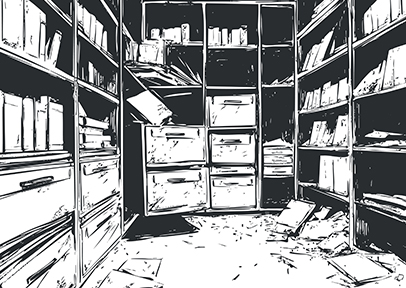By: James Pawlish
When organizations discover they have been named in a lawsuit or face environmental contamination tied to past business operations, it can be overwhelming. What many don’t realize is that their greatest financial resource may already exist, within their own history.
Insurance Archaeology is the process of identifying and leveraging liability insurance policies issued decades ago to fund today’s cleanup obligations. These policies, often overlooked or forgotten, can cover millions of dollars in investigation, remediation, and legal expenses. Unfortunately, myths and misunderstandings prevent many businesses, municipalities, and property owners from pursuing these opportunities.
At PolicyFind, we’ve spent decades unraveling the myths. Here are the top five misconceptions about historical insurance recovery, and the truths that could change how you view environmental liability.
1. “Old Insurance Policies No Longer Matter.”
The misconception: Because the policies were written decades ago, many assume they have expired or have no bearing on today’s claims.
The reality: In fact, the opposite is true. Occurrence-based general liability policies never expire. This means they cover damages arising from events that occurred during the policy period, even if the contamination isn’t discovered until decades later.
For example, if a dry cleaner operated from 1960–1980 and a solvent release is found today, an occurrence-based general liability policy written during those years may still provide coverage. Courts across the country have consistently upheld the continuing validity of these policies. They don’t expire with time, making them one of the most enduring corporate assets a business can hold.
Why it matters: Even if your operations ended long ago, your insurance legacy may still protect you.
2. “We Don’t Have Our Old Insurance Policies, So Recovery Isn’t Possible.”
The misconception: Companies often assume that without the actual policy document, recovery is impossible.
The reality: This is where insurance archaeology comes in. Specialists can reconstruct missing coverage through secondary evidence, broker records, old accounting files, regulatory filings, or even correspondence referencing policy numbers. Court rulings have established that secondary evidence can be just as valid in proving coverage as the policy itself.
At PolicyFind, we routinely uncover evidence in places our clients never thought to look: archived municipal files, corporate board minutes, storage facilities, and even personal files of former executives.
Why it matters: You don’t need the original paper policy. If coverage existed, there are often breadcrumbs that can be followed to prove its existence.
3. “Pursuing Historical Insurance Recovery Is Too Expensive.”
The misconception: Businesses believe the process is cost-prohibitive, especially when they’re already facing expensive remediation and legal bills.
The reality: In practice, historical insurance recovery is an investment that pays for itself many times over. A single policy can unlock millions of dollars in coverage.
Why it matters: The potential return on investment is enormous. What may seem like a cost is a pathway to substantial financial relief.
4. “Insurance Companies Never Pay on Old Claims.”
The misconception: Many believe insurance carriers always deny historical claims, making the process futile.
The reality: While insurance carriers can contest these claims, the courts have been clear: ‘if coverage existed, it remains enforceable.’ Over the past 30 years, thousands of insureds, from multinational corporations to family-owned businesses, have successfully recovered under old liability policies.
Recovery isn’t automatic, but with thorough documentation and experienced advocates, policyholders routinely secure funding. Insurers know this, which is why many claims are resolved through negotiation and settlement rather than litigation.
Why it matters: History is on the side of policyholders who can prove coverage.
5. “Historical Insurance Recovery Is Only for Large Corporations.”
The misconception: Smaller businesses or municipalities assume this strategy is reserved for Fortune 500 companies.
The reality: Some of the most successful recoveries have been for small enterprises and local governments. Dry cleaners, auto repair shops, gas stations, plating shops, and small manufacturers often operated under the very types of policies most useful today. Municipalities, too, may have coverage extending back decades that can be applied to brownfield sites, landfills, or abandoned industrial properties.
In many cases, the scale of the recovery is life-changing. A small business facing financial ruin from cleanup costs can stabilize and even thrive once coverage is secured. A city strapped for redevelopment funds can transform abandoned lots into tax-generating properties.
Why it matters: Historical insurance recovery levels the playing field, empowering businesses and communities of all sizes to address legacy contamination.
The Bigger Picture: Why Dispelling These Myths Matters
The stakes are high. Long-tail and latent injury liabilities don’t just affect the bottom line; they impact future fiscal health, growth, property values, community health, redevelopment potential, and even reputations. Misconceptions about historical insurance cause businesses and communities to settle cases for millions out of their own pockets, walk away from resources that could transform liabilities into opportunities.
By pursuing insurance archaeology and recovery, organizations can:
- Access critical funding for environmental investigations and cleanups.
- Offset legal and consulting costs associated with regulatory compliance.
- Unlock redevelopment potential for properties once considered too risky.
- Protect balance sheets from unexpected environmental liabilities.
At PolicyFind, we’ve seen firsthand how dispelling these myths empowers organizations to reclaim control of these challenges. Historical insurance recovery isn’t just about recouping costs or providing funds to injured parties—it’s about creating a foundation for growth, revitalization, and long-term resilience.
Don’t let misconceptions block access to coverage you already own. PolicyFind can help uncover historical insurance that protects your future.

